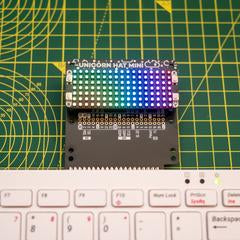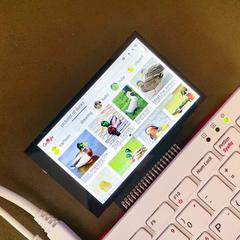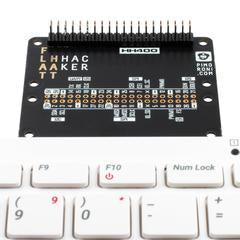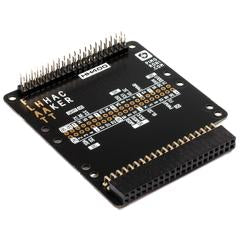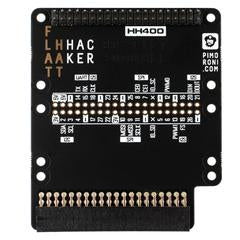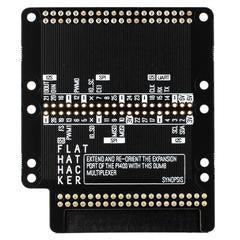Flat HAT Hacker ist eine einfache Möglichkeit, HATs und Mini-HATs auf der Rückseite Ihres Pi 400 so zu befestigen, dass ihre Ausrichtung mit der Tastatur Ihres Pi 400 übereinstimmt. Sie könnten damit ein hochauflösendes Touchscreen-Display/Bedienfeld, die 3,5-mm-Audiohardware, die Sie vermisst haben, oder sogar die pompöseste Feststelltaste der Welt anbringen.
Die oberste Reihe der GPIO-Pins ist mit einer vorgelöteten Stiftleiste bestückt, so dass Sie einen HAT oder Mini-HAT einfach und ohne viel Aufhebens anschließen können. In der Mitte der Platine hat Pimoroni einen zweiten Satz von Kontakten (mit praktischen Beschriftungen) angebracht - hier können Sie eine 40-polige Stiftleiste anlöten, wenn Sie zwei Mini-HATs auf einmal verwenden möchten (oder wenn Sie Drähte zu den GPIOs für Prototypen oder zum Anschluss an andere Schaltungen führen möchten). Pimoroni hat auch Befestigungslöcher in passenden Abständen vorgesehen, damit Sie Ihre HATs und Mini-HATs mit Abstandshaltern befestigen können.
Hinweis: Header und Standoffs sind separat erhältlich - schauen Sie sich die Registerkarte Extras an!
Merkmale:
- Landebereich für einen HAT oder Mini-HAT mit vorinstalliertem 40-poligem Steckverbinder
- Landebereich für einen Mini-HAT ohne vorinstallierten Stecker
- GPIO-Pins auf der zweiten Landefläche mit Funktionen und BCM-Pin-Nummern beschriftet
- 10 Montagelöcher zur Befestigung von einem HAT oder zwei Mini-HATs
- Vorinstallierte rechtwinklige 40-polige Buchse zum Anschluss an den GPIO des Pi
- Löten ist nur erforderlich, wenn der zweite Landebereich genutzt werden soll
Hinweise:
- Wenn Sie planen, mehrere mini HATs in Ihrem Projekt zu verwenden, müssen Sie auf GPIO-Konflikte achten - Pinout.xyz und pHAT Stack Configurator sind hierfür hilfreich!
- Wenn Sie ein gefährlicher Abtrünniger sind, könnten Sie diese Platine auch mit einem normalen Raspberry Pi verwenden, in diesem Fall würde sie senkrecht in 'Flag HAT Hacker'-Formation aufragen. Dies ist potenziell nützlich, um HATs und Mini-HATs im rechten Winkel zu Ihrem Pi zu montieren, wobei der Pi als praktischer Ständer dient!
English Description
The Flat HAT Hacker is an easy way to attach HATs and Mini-HATs to the back of your Pi 400, aligning them with the keyboard. Perfect for mounting a high-resolution touchscreen display, the 3.5mm audio hardware you’ve been missing, or even the most extravagant Caps Lock key.
The top row of GPIO pins comes with a pre-soldered header, making it simple to connect a HAT or Mini-HAT. In the center of the board, Pimoroni has included a second set of contacts with handy labels. You can solder on a 40-pin header here if you want to use two Mini-HATs at once or to run wires to the GPIOs for prototyping or connecting to other circuits. There are also mounting holes spaced appropriately for securing your HATs and Mini-HATs with standoffs.
Features:
- Mounting area for a HAT or Mini-HAT with pre-installed 40-pin connector
- Mounting area for a Mini-HAT without pre-installed connector
- GPIO pins on the second landing area labeled with functions and BCM pin numbers
- 10 mounting holes for securing one HAT or two Mini-HATs
- Pre-installed right-angle 40-pin socket for connecting to the Pi’s GPIO
- Soldering is only required if using the second landing area
Notes:
- If using multiple Mini-HATs in your project, be mindful of GPIO conflicts—Pinout.xyz is a useful tool.
- For adventurous users, this board can also be used with a regular Raspberry Pi, standing vertically in a "Flag HAT Hacker" formation. This is potentially useful for mounting HATs and Mini-HATs at a right angle to your Pi, with the Pi acting as a handy stand.
Sicherheitsangaben
- Lesen Sie die Bedienungsanleitung sorgfältig durch, bevor Sie das Produkt verwenden.
- Stellen Sie sicher, dass alle Montage- und Installationsanweisungen des Herstellers sorgfältig befolgt werden.
- Verwenden Sie das Produkt nur für den vorgesehenen Zweck.
- Die unsachgemäße Nutzung dieses Produkts kann zu schweren Verletzungen oder Sachschäden führen.
- Nicht für Kinder unter 10 Jahren geeignet.
- Bei unsachgemäßer Verwendung besteht eine Verletzungsgefahr.
- Dieses Produkt entspricht den geltenden Sicherheitsanforderungen der Europäischen Union.
- Dieses Produkt wurde gemäß der GPSR geprüft, die sicherstellt, dass alle relevanten Sicherheitsanforderungen für Konsumgüter eingehalten werden.
Nachverfolgbarkeitsinformationen
Jedes Produkt verfügt über eines oder mehrere der folgenden Merkmale:
- Ein CE-Kennzeichen, das die Einhaltung der Sicherheits-, Gesundheits- und Umweltschutzanforderungen der Europäischen Union anzeigt.
- Eine eindeutige Serien- oder Chargennummer, um die Nachverfolgbarkeit zu gewährleisten und bei Bedarf Rückrufaktionen zu unterstützen.
- Hersteller- und Importeurangaben für den Kundensupport und Sicherheitsanfragen.
Überwachung und Berichterstattung von Vorfällen
Für den unwahrscheinlichen Fall eines Produktproblems haben wir Verfahren implementiert, um:
- Kundenbeschwerden zeitnah bearbeiten.
- Schwerwiegende Vorfälle über das EU Safety Gate/RAPEX-System melden.
- Mit den Marktüberwachungsbehörden zusammenarbeiten, um die öffentliche Sicherheit zu gewährleisten.
Kontakt:
- Email: support [@] pi3g.com
- Telefon: 0341 / 392 858 40
Dieses Produkt ist vollständig mit allen geltenden EU-Vorschriften konform, um die Sicherheit unserer geschätzten Kunden zu gewährleisten.

